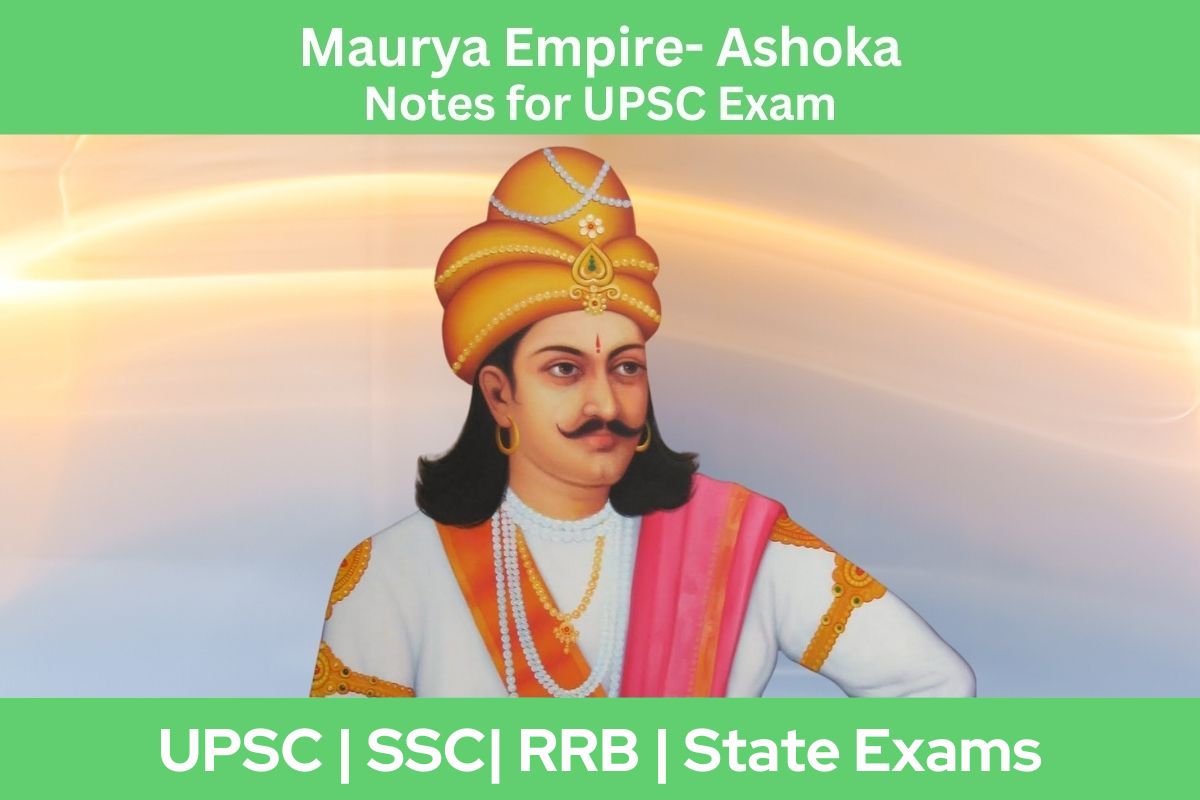
Ashoka
- After Bindusara’s death in 273 BCE, there was a four-year struggle for succession. Bindusara wished for his son Susima to be his successor.
- However, Ashoka, another son of Bindusara, with the assistance of his minister Radhagupta, managed to claim the throne by defeating and eliminating his 99 brothers.
- Before ascending the throne, Ashoka had served as the Viceroy of Taxila and Ujjain, which were important cities for trade and commerce during Bindusara’s rule.
- Ashoka is renowned as one of history’s greatest kings. He was the first ruler to establish direct communication with his people through inscriptions.
- He was known by various names, including Buddhashakya, Dharmasoka, Devanampiya (beloved of the gods), and Piyadassi (of pleasing appearance), as mentioned in Sri Lankan Buddhist chronicles Dipavamsa and Mahavamsa.
- These texts provide detailed information about Ashoka’s queens. He was married to Mahadevi, the daughter of a merchant from Vidisha, who gave birth to Mahendra and Sanghamitra, well-known figures in the spread of Buddhism.
- Buddhist texts also mention other queens like Asandhimitta, Padmavati, Tissarakhita, and Karuvaki, the only queen mentioned in the queen’s edict, where she is described as the mother of Prince Tivara, the only son of Ashoka mentioned by name in inscriptions.
- During Ashoka’s reign, the Mauryan Empire extended from Hindukush to Bengal, covering Afghanistan, Baluchistan, India, Kashmir, Nepal valleys, with only a small part in the far south occupied by the Cholas and Pandyas, according to his rock edicts.
- Ashoka established diplomatic relations with rulers in Syria, Egypt, Macedonia, Cyrenaica (Libya), and Alexander of Epirus, as documented in the Edicts of Ashoka.
- Ashoka embraced Buddhism and played a significant role in its expansion. He sent his children, Mahendra and Sanghamitra, to Sri Lanka (Ceylon) to promote Buddhism.
- He appointed Dharma Mahamattas to spread moral and ethical teachings among various social groups, including women, during the 14th year of his reign.
- During his 21st year as king, he made a pilgrimage to Lumbini, the birthplace of Buddha.
- Ashoka implemented policies to ban animal sacrifices, regulate the slaughter of animals for food, and established places like dharmashalas, hospitals, and sarais throughout his kingdom.
Brihadratha
- After Ashoka’s rule, the Mauryan empire began to lose its strength. Subsequent kings ruled for brief periods.
- The empire’s decline ultimately led to its downfall. The Mauryan dynasty came to an end when the last Mauryan king, Brihadratha, was assassinated by his military commander, Pushyamitra Sunga, in 187 BCE.
Ashokan Inscriptions and Ashoka’s Dharma
- We learn about Ashoka’s history from his inscriptions.
- He was the first Indian king to communicate with the people through these writings.
- His inscriptions provide information about Ashoka’s life, his actions both inside and outside his kingdom, the size of his empire, and his beliefs about dhamma.
Kalinga War Impact
- After becoming king, Ashoka engaged in one major conflict, the Kalinga war. This war resulted in the death of 100,000 people and 150,000 were taken as prisoners.
- The suffering experienced by Brahmana priests and Buddhist monks deeply saddened Ashoka.
- As a result, he shifted from using force to spread his rule to a policy of cultural influence.
- This transition from “bherighosha” to “dhammagosha” is mentioned in the 13th Major Rock Edict.
- Following the Kalinga war, Ashoka aimed to win over foreign territories through ideas and not military force.
- Even though he kept Kalinga as a part of his empire after the war, the Kalinga conflict didn’t turn Ashoka into an extreme pacifist.
- Instead, he adopted a practical approach to strengthen his empire. He encouraged tribal people to follow dharma, which meant adhering to established social rules and moral values. He appointed officers known as rajukas to enforce justice.
- After the Kalinga war, Ashoka embraced Buddhism and became a monk.
- He generously supported Buddhists and went on pilgrimages to important Buddhist sites.
- A Buddhist council, led by his brother, was convened, and missionaries were dispatched to regions like South India, Sri Lanka, and Burma to promote Buddhism.
- Ashoka also appointed officers called dharma mahamatras to spread the principles of dharma among various social groups, including women.
Ashoka’s Legacy
- Ashoka is celebrated as a remarkable ruler in the history of ancient India and the world. Some of his significant achievements include:
- Unifying the nation politically: He brought the entire country together by promoting a common dhamma (moral code), language, and the widespread use of the Brahmi script in his inscriptions.
- Fostering tolerance and respect: Ashoka advocated and practiced religious tolerance and respected different scripts and languages.
- He didn’t impose his religious beliefs on his subjects and even made donations to non-Buddhist sects, like the Ajivika sect. He also acknowledged scripts such as Kharoshti, Aramaic, and Greek.
- Promoting cultural connections: In addition to transforming his administration, he encouraged cultural exchanges between Indian states and with other regions of the world. Ashoka can be seen as India’s first global cultural ambassador.
- Pursuing a policy of peace and non-aggression: Ashoka is renowned for his commitment to peace, avoiding conquest and aggression.
MCQ Test on Maurya Empire- Ashoka GK MCQs With Answer & Explanation in English








